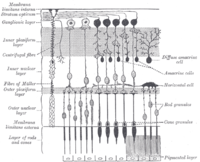
Photo from wikipedia
The river hippopotamus (Hippopotamus amphibius), one of the closest extant relatives to cetaceans, is a large African even‐toed ungulate (Artiodactyla) that grazes and has a semiaquatic lifestyle. Given its unusual… Click to show full abstract
The river hippopotamus (Hippopotamus amphibius), one of the closest extant relatives to cetaceans, is a large African even‐toed ungulate (Artiodactyla) that grazes and has a semiaquatic lifestyle. Given its unusual phenotype, ecology, and evolutionary history, we sought to measure the topographic distribution of retinal ganglion cell density using stereology and retinal wholemounts. We estimated a total of 243,000 ganglion cells of which 3.4% (8,300) comprise alpha cells. The topographic distribution of both total and alpha cells reveal a dual topographic organization of a temporal and nasal area embedded within a well‐defined horizontal streak. Using maximum density of total ganglion cells and eye size (35 mm, axial length), we estimated upper limits of spatial resolving power of 8 cycles/deg (temporal area, 1,800 cells/mm2), 7.7 cycles/deg (nasal area, 1,700 cells/mm2), and 4.2 cycles/deg (horizontal streak, 250 cells/mm2). Enhanced resolution of the temporal area toward the frontal visual field may facilitate grazing, while resolution of the horizontal streak and nasal area may help the discrimination of objects (predators, conspecifics) in the lateral and posterior visual fields, respectively. Given the presumed role of alpha cells to detect brisk transient stimuli, their similar distribution to the total ganglion cell population may facilitate the detection of approaching objects in equivalent portions of the visual field. Our finding of a nasal area in the river hippopotamus retina supports the notion that this specialization may enhance visual sampling in the posterior visual field to compensate for limited neck mobility as suggested for rhinoceroses and cetaceans.
Journal Title: Journal of Comparative Neurology
Year Published: 2017
Link to full text (if available)
Share on Social Media: Sign Up to like & get
recommendations!